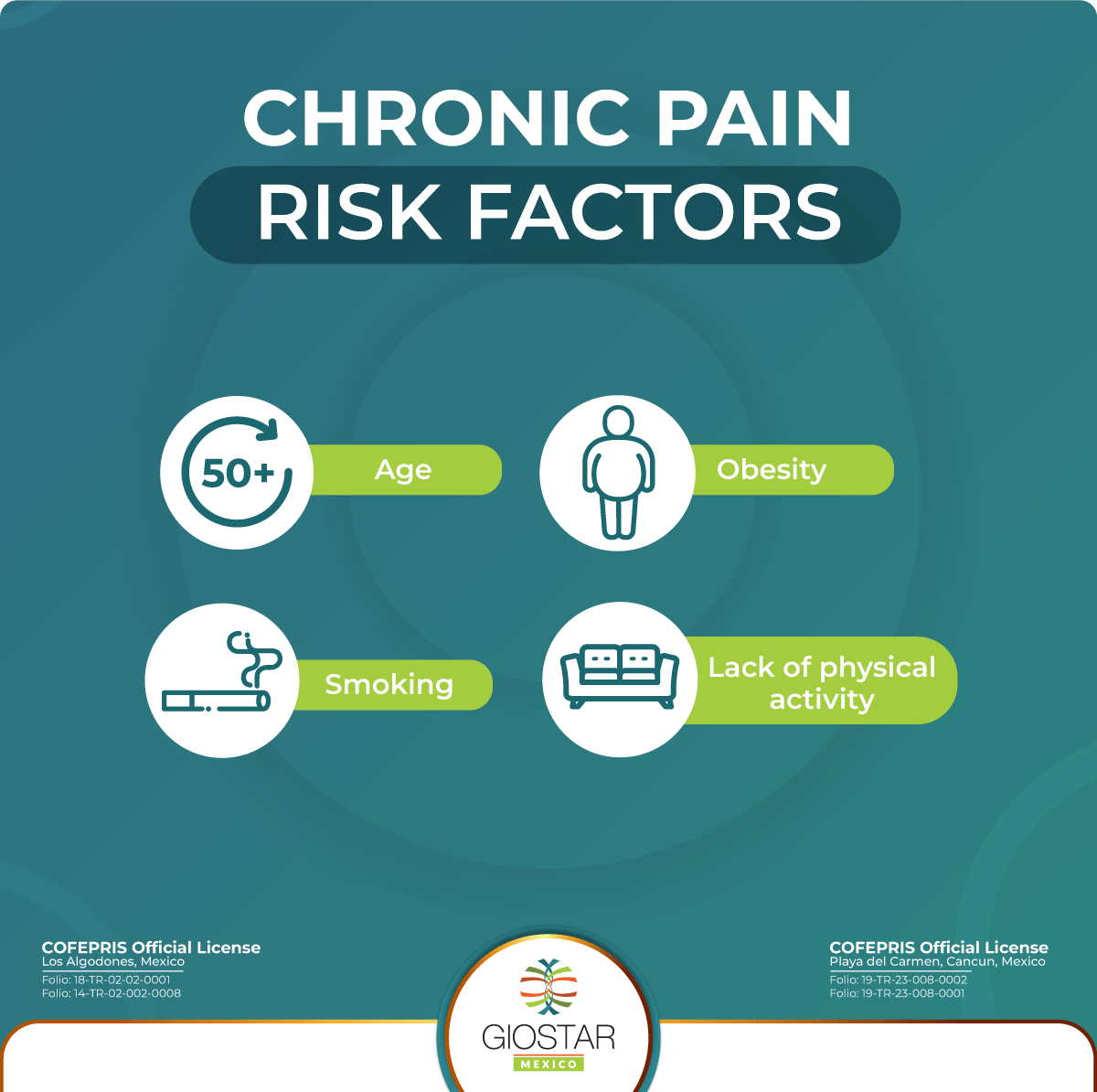What is chronic pain?
Chronic pain is a complex condition that requires a multidisciplinary approach to management. Treatment options may include medication, physical therapy, psychological counseling, or surgery, depending on the underlying cause and severity of the pain. In recent years, stem cell therapy has emerged as a promising treatment for chronic pain, with the potential to regenerate damaged tissues and reduce inflammation. It is important to seek medical attention if you are experiencing chronic pain, as early intervention can improve outcomes and prevent long-term complications.

 There are many different types of chronic pain, which can be classified based on the location and intensity of pain. Some of the most common types of chronic pain include neuropathic pain, which is caused by nerve damage and is often described as a burning or shooting pain. Another type is inflammatory pain, which is caused by inflammation in the body and is often described as a throbbing pain. There is also mechanical pain, which is caused by an injury or overuse of a muscle or joint and is often described as a dull ache. Identifying the specific type and cause of chronic pain is essential in developing an effective treatment plan.
There are many different types of chronic pain, which can be classified based on the location and intensity of pain. Some of the most common types of chronic pain include neuropathic pain, which is caused by nerve damage and is often described as a burning or shooting pain. Another type is inflammatory pain, which is caused by inflammation in the body and is often described as a throbbing pain. There is also mechanical pain, which is caused by an injury or overuse of a muscle or joint and is often described as a dull ache. Identifying the specific type and cause of chronic pain is essential in developing an effective treatment plan.
 Chronic pain can also be a result of an injury, illness, or medical condition, such as arthritis or diabetes. Additionally, psychological factors such as stress, anxiety, and depression can contribute to chronic pain. Individuals who have experienced trauma, abuse, or neglect are also at an increased risk for chronic pain. Understanding these risk factors can help healthcare professionals identify and address the underlying causes of chronic pain, leading to improved outcomes for patients.
Chronic pain can also be a result of an injury, illness, or medical condition, such as arthritis or diabetes. Additionally, psychological factors such as stress, anxiety, and depression can contribute to chronic pain. Individuals who have experienced trauma, abuse, or neglect are also at an increased risk for chronic pain. Understanding these risk factors can help healthcare professionals identify and address the underlying causes of chronic pain, leading to improved outcomes for patients.

What is chronic pain?
Chronic pain is a long-lasting pain that persists for more than 12 weeks, even after the initial injury or disease has healed. It is a complex condition that affects the nervous system and can be caused by various factors, including injury, disease, inflammation, or aging. Unlike acute pain, which is a normal response to injury or tissue damage, chronic pain is a persistent and ongoing discomfort that can significantly impact an individual’s quality of life. There are several types of chronic pain, including neuropathic, nociceptive, and centralized pain. Neuropathic pain is caused by damage or dysfunction of the nervous system, resulting in tingling, burning, or shooting sensations. Nociceptive pain, on the other hand, is caused by tissue damage or inflammation and is characterized by throbbing or aching pain. Centralized pain, also known as fibromyalgia, is a condition in which the central nervous system becomes hypersensitive, causing widespread pain and discomfort.What causes chronic pain?
There are various causes and types of chronic pain that can affect individuals. One of the most common causes of chronic pain is musculoskeletal conditions such as osteoarthritis, fibromyalgia, and lower back pain. Other causes include nerve damage, autoimmune disorders, and certain cancers. Chronic pain can also be a result of an initial injury that did not heal properly. There are many different types of chronic pain, which can be classified based on the location and intensity of pain. Some of the most common types of chronic pain include neuropathic pain, which is caused by nerve damage and is often described as a burning or shooting pain. Another type is inflammatory pain, which is caused by inflammation in the body and is often described as a throbbing pain. There is also mechanical pain, which is caused by an injury or overuse of a muscle or joint and is often described as a dull ache. Identifying the specific type and cause of chronic pain is essential in developing an effective treatment plan.
There are many different types of chronic pain, which can be classified based on the location and intensity of pain. Some of the most common types of chronic pain include neuropathic pain, which is caused by nerve damage and is often described as a burning or shooting pain. Another type is inflammatory pain, which is caused by inflammation in the body and is often described as a throbbing pain. There is also mechanical pain, which is caused by an injury or overuse of a muscle or joint and is often described as a dull ache. Identifying the specific type and cause of chronic pain is essential in developing an effective treatment plan.
Chronic pain risk factors
There are several risk factors associated with chronic pain, including age, gender, and lifestyle factors. As individuals age, the likelihood of developing chronic pain increases. Women are also more likely to experience chronic pain than men, and there may be hormonal and genetic factors that contribute to this difference. Other lifestyle factors that increase the risk of chronic pain include obesity, smoking, and lack of physical activity. Chronic pain can also be a result of an injury, illness, or medical condition, such as arthritis or diabetes. Additionally, psychological factors such as stress, anxiety, and depression can contribute to chronic pain. Individuals who have experienced trauma, abuse, or neglect are also at an increased risk for chronic pain. Understanding these risk factors can help healthcare professionals identify and address the underlying causes of chronic pain, leading to improved outcomes for patients.
Chronic pain can also be a result of an injury, illness, or medical condition, such as arthritis or diabetes. Additionally, psychological factors such as stress, anxiety, and depression can contribute to chronic pain. Individuals who have experienced trauma, abuse, or neglect are also at an increased risk for chronic pain. Understanding these risk factors can help healthcare professionals identify and address the underlying causes of chronic pain, leading to improved outcomes for patients.
What is the best pain medication for chronic pain?
When it comes to chronic pain, there are various treatment and medication options available depending on the underlying cause of the pain. Medications such as nonsteroidal anti-inflammatory drugs (NSAIDs), opioids, and antidepressants can be used to manage pain. Additionally, physical therapy which includes exercises, stretches, and massage, can help to strengthen muscles, reduce inflammation, and improve mobility. In some cases, surgery may be necessary to address the underlying cause of the pain.Stem cell therapy for pain
A new treatment option for chronic pain is stem cell therapy. Stem cells have the ability to differentiate into different types of cells and tissues, and they can be used to repair or replace damaged cells in the body. Stem cell therapy has shown potential in treating various chronic pain conditions, such as neuropathic pain, spinal cord injuries, and osteoarthritis. The best pain medication for chronic pain depends on the individual and the specific pain condition, so it’s important to consult with a healthcare professional to determine the most effective treatment plan.Giostar Mexico chronic pain management treatment
The use of mesenchymal stem cells for pain management and muscular injury will direct the stem cells to the damaged area, helping the immune system to reduce the inflammatory response caused by injuries, as well as boost the own body’s production of new cells that will help stop the pain and regenerate the damaged tissue. Stem cell therapy, being part of the regenerative medicine field, has increasingly become an attractive alternative to otherwise painful surgeries that require time, effort and rest in order to recover from the intervention. All of our treatments receive a personalized protocol from our medical directors, who in turn consult with Dr Anand Srivastava (our Chief Scientist Officer and Co-Founder). This translates to safety for patients of stem cell therapy, knowing that each protocol is developed by highly trained medical professionals with a scientific background. You will not find this easily in other clinics, even countries.How much does stem cell therapy cost?
The cost of Stem Cell Therapy needs to be determined by our expert medical team, as prices depend on the specific condition and personalized medical recommendations. Our dedicated team of medical professionals carefully evaluates each patient’s unique health situation to recommend the most effective therapy. Stem Cell Therapy includes the following:-
-
- Laboratory protocol by Dr. Anand (activation of the stem cells to direct them towards the affected tissue or organ)
- 1 – 3 stem cell vials (35 – 105 million stem cells)
- 1 – 10 billion exosomes (volume depends on the doctor’s personal evaluation of each patient)
- Oxygen Therapy
- Body preparation
- Medical Consultation
- Dietitian Follow-up post-therapy
- Transportation hotel-clinic in local shuttle
- Lodging (available in our Clinic in Algodones) at Hotel Hacienda or Hotel Cielito Lindo
- Preferential prices for future reinforcements/applications
-
References
- Huang, Y. C., Liu, H. T., & Lin, K. H. (2019). Mesenchymal stem cells—From basic research to clinical applications. Journal of biomedical science, 26(1), 1-14.
- Vickers, A. J., & Linde, K. (2014). Acupuncture for chronic pain. JAMA, 311(9), 955-956.
- National Institute of Neurological Disorders and Stroke. (2021). Chronic Pain Information Page. Retrieved from https://www.ninds.nih.gov/Disorders/All-Disorders/Chronic-Pain-Information-Page
- Blyth, F. M., March, L. M., Brnabic, A. J., & Jorm, L. R. (2001). Chronic pain in Australia: a prevalence study. Pain, 89(2-3), 127-134.
- Finnerup, N. B., Haroutounian, S., Kamerman, P., Baron, R., Bennett, D. L., Bouhassira, D., … & Tölle, T. (2016). Neuropathic pain: an updated grading system for research and clinical practice. Pain, 157(8), 1599-1606.
- Smith, S. M., Soneji, N., & Katz, J. (2014). Quality of reporting of randomized controlled trials of pharmacologic treatment of chronic pain using the CONSORT standards. The Clinical journal of pain, 30(6), 555-563.
- Blyth, F. M., Briggs, A. M., Schneider, C. H., & Hoy, D. G. (2019). The global burden of musculoskeletal pain—Where to from here?. American Journal of Public Health, 109(1), 35-40.
- Dersh, J., Gatchel, R. J., Polatin, P. B., & Mayer, T. G. (2002). Prevalence of psychiatric disorders in patients with chronic disabling occupational spinal disorders. Spine, 27(22), 2508-2514.
- Johannes, C. B., Le, T. K., Zhou, X., Johnston, J. A., & Dworkin, R. H. (2010). The prevalence of chronic pain in United States adults: results of an Internet-based survey. The Journal of Pain, 11(11), 1230-1239.

